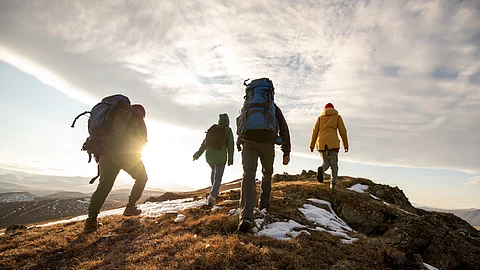
- Destinations
- Experiences
- Stay
- What's new
- Editor’s Picks
- Responsible Tourism
- CampaignsCampaigns
- Subscribe

Do you love trekking but hate carrying the burden of a heavy backpack? Do you want to enjoy the beauty of nature without leaving a negative trail of impact? Do you wish to save money and time while having a memorable adventure? If you answered yes to any of these questions, then this minimalist trekking guide is for you. Minimalist trekking is a way of travelling light and smart, with only the essential items that you need for your journey. It is not only good for the environment, but also for your health and your wallet.
It's essential to invest in high-quality gear that is lightweight and durable. Choosing cutting-edge materials will give you the perfect balance of strength and portability. You can make wise choices by selecting ultralight tents, sleeping bags, and clothing, which won't weigh you down. Remember that quality gear is worth the investment, as it will last longer and make your outdoor experience more enjoyable.
Restrict your clothing choices to versatile, multi-purpose garments. Merino wool, for instance, offers superb moisture-wicking properties and odour resistance. Layering is key; a few adaptable pieces can handle a variety of weather conditions.
Ditch the bulky cookware and select minimalist cooksets that serve your culinary needs without superfluous weight. A lightweight stove and compact cookware can be a utilitarian choice.
Calculate your daily nutritional needs and pack accordingly. Opt for dehydrated meals, energy-dense snacks, and lightweight cooking ingredients. Repackage items to minimize excess packaging.
Carrying copious amounts of water can be burdensome. Invest in a water filtration system or purification tablets to source water along the trail, reducing the weight of your initial load.
Scale down your personal hygiene and toiletry items. Travel-sized containers, biodegradable soap, and minimalist hygiene products are the order of the day.
The weight of your footwear matters on tough terrains. Look for lightweight, yet supportive hiking boots or trail shoes that suit the terrain. Extra pairs of socks are more practical than multiple shoe options.
Organize your gear with meticulous precision. Utilize compression sacks and dry bags to maximize space and protect against the elements. Distribute weight evenly to enhance comfort during the trek.
Each item should earn its place in your backpack, what not to pack is more essential than what to pack, as it may turn out to be a hurdle in your journey. Scrutinize your gear list and eliminate non-essential items. Consider sharing items with your trekking companions to lighten the collective load.
Lastly, you will need to adopt the mindset of an ultralight trekker. Constantly reassess your gear choices, seeking to minimize weight without compromising safety or comfort.
